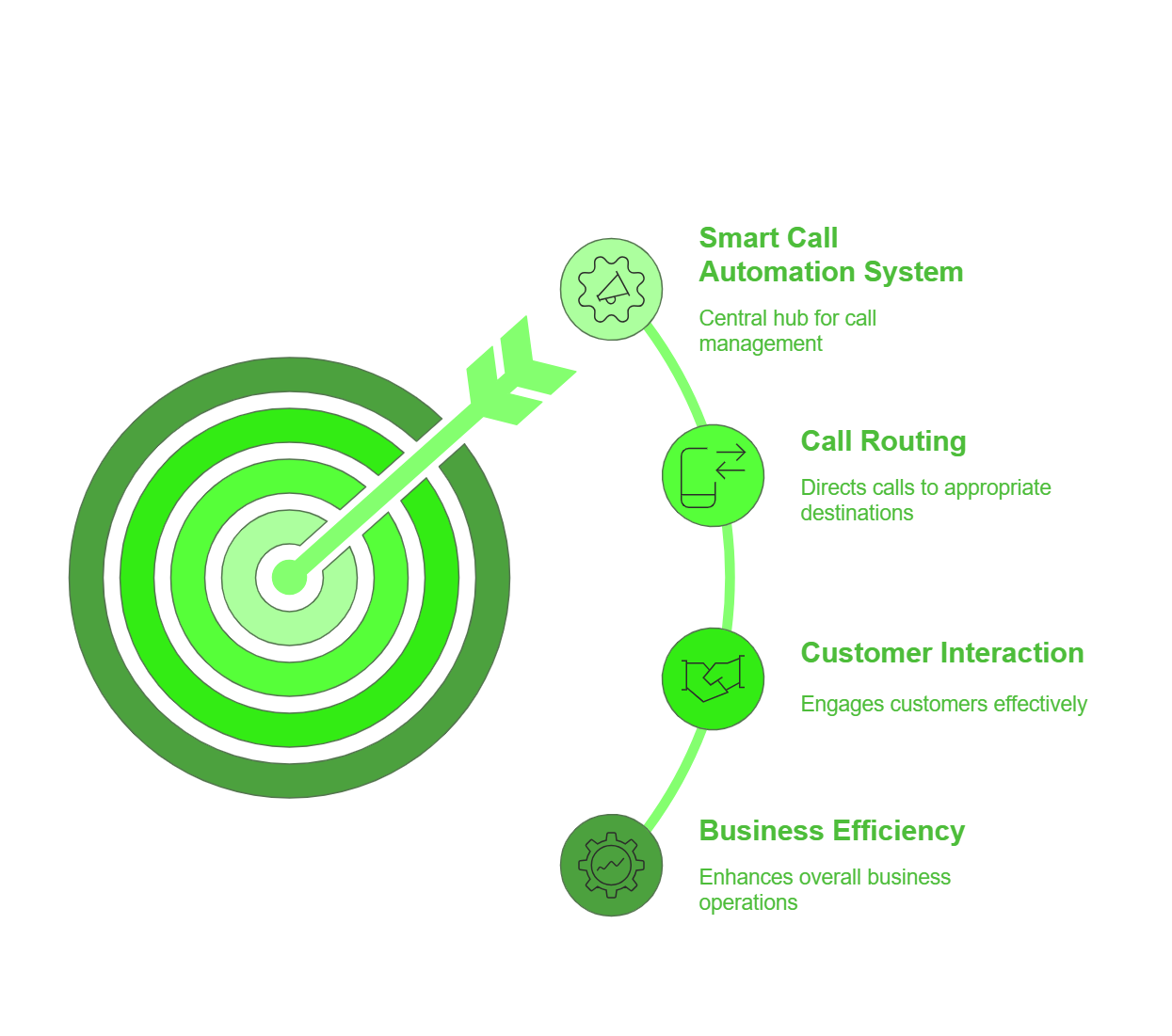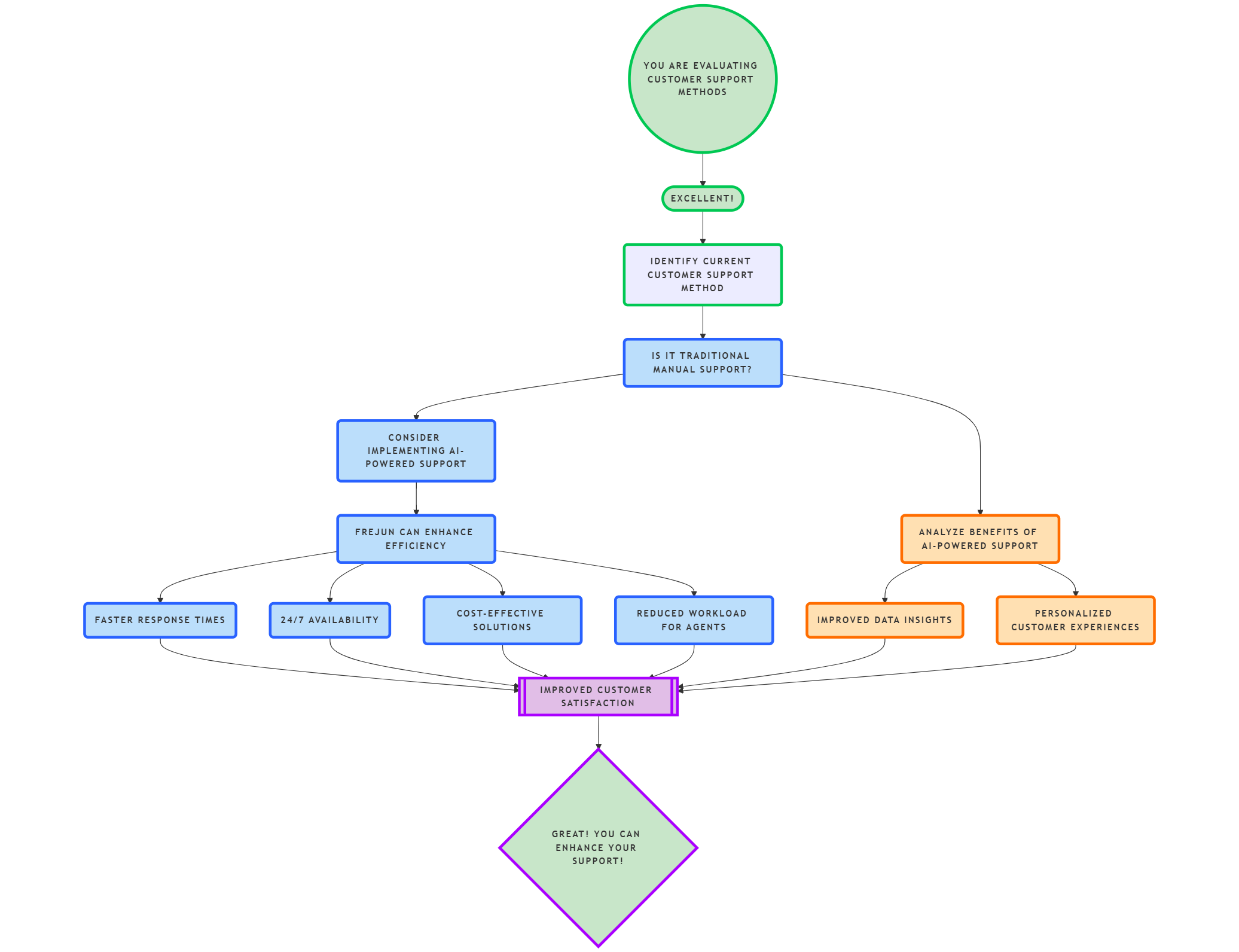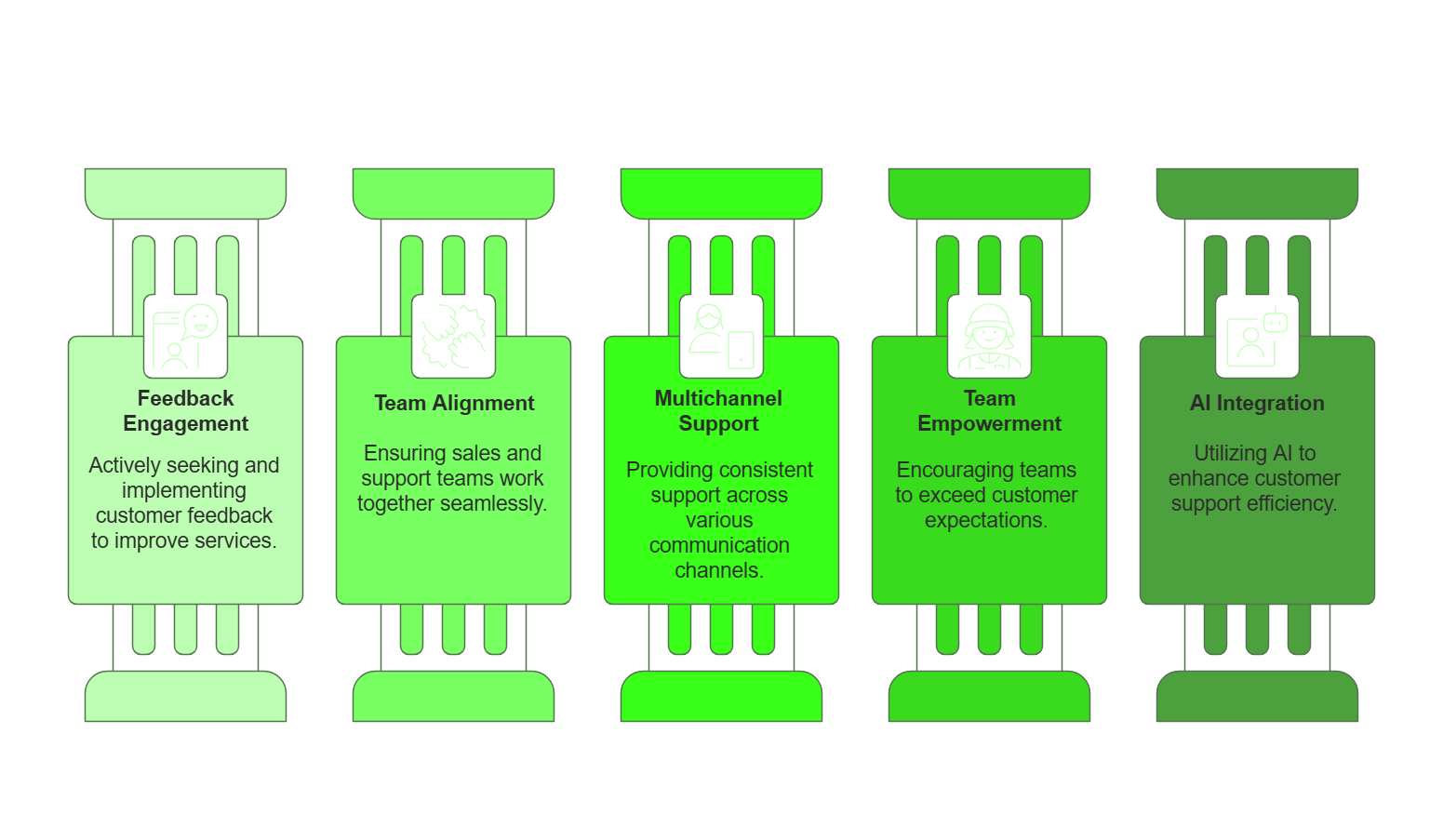Last updated on June 30th, 2025 at 03:17 pm
Every brand strives to keep its customers satisfied. It can help increase brand loyalty, and retail customers, boost trust, and grow the user base But most important of them all, customer satisfaction affects your business sales. Improving Customer Satisfaction remains at the core of any successful business strategy, especially as we step into 2025. With advancements in technology and evolving customer expectations, keeping your customers happy requires a thoughtful and modern approach. We know that a happy customer is more likely to return to your brand for repeat business. But that’s not all. A satisfied customer will also refer your brands to their friends, family, and colleagues. And we all know how impactful word-of-mouth marketing is. A Semrush study reveals that 90% of people are likely to trust a brand recommended to them by another user. No business would want to miss out on that! Businesses can boost their customer satisfaction by following some straightforward tips. But before that, let’s understand what customer satisfaction is.
Customer satisfaction isn’t just about resolving complaints it’s about delivering consistent, personalized, and seamless experiences across every touchpoint. In today’s digital-first world, communication plays a massive role in shaping these experiences. This is where platforms like WhatsApp, powered by a virtual number from FreJun, can make a real difference. It enables businesses to offer quick responses, 24/7 support, and personalized updates—all within a channel customers already use and trust. By meeting your customers where they are, and responding with speed and relevance, you significantly improve satisfaction and retention.
What Are Some Actionable Yet Simple Strategies Businesses Can Use To Improving Customer Satisfaction In 2025?
In 2025, customer satisfaction is deeply tied to speed, personalization, and seamless digital experiences. These are the 6 quick yet highly effective strategies businesses can use:
- Respond Faster With Automation: Use tools like FreJun’s WhatsApp virtual number to automate greetings, FAQs, and follow-ups, reducing response times and delighting customers.
- Listen Actively: Monitor feedback through surveys, social media, or direct communication. Show customers you value their opinion by making changes based on their input.
- Train Your Support Team: A well-trained support team can handle queries efficiently and empathetically. Make sure they’re familiar with your product and equipped with the right tools.
- Offer Omnichannel Support: Be present where your customers are—whether it’s WhatsApp, email, live chat, or social platforms—and maintain consistency across channels.
- Personalize Every Interaction: Use customer data to offer personalized responses and recommendations. This makes your customers feel seen and appreciated.
- Follow Up After Resolutions: Don’t just solve a problem and move on. Follow up to ensure the customer is happy with the outcome. It shows you care about long-term satisfaction.
What is Customer Satisfaction?
Before delving into the depth of improving customer satisfaction, we need to understand what it means and why it’s so essential for your business.
In simple terms, customer satisfaction is the measure of a customer’s happiness with your company’s product or customer experience. Today’s customers juggle through different touchpoints in their journey to tell whether they are satisfied or dissatisfied with a brand. Right from when they get to know about your business until after they become brand loyal, each interaction they have constitutes a customer experience. And it would be better to satisfy customers.
Their satisfaction is not just measured based on their experience with your product. It is now determined by their experience through different channels. Your social media pages, online advertisements, brand website, application, influencer mentions, sales staff, support staff, physical/digital product experience, and many more touchpoints make up the customer experience. Customer satisfaction determines if a customer would become an active and repeat buyer or simply turn awry from the brand.
It can help boost business, differentiate from your competitors, retain customers, and even make them loyal advocates of your brand. A Salesforce research states that 89% of customers are more likely to become repeat customers of the brand due to a positive customer experience. And 80% of customers surveyed in a ZenDesk report confirmed that a single bad experience is enough for them to move to the competitor.
No wonder businesses are increasingly interested in ways to boost their customer satisfaction through offering a better experience. And that’s what we have discussed in this write-up. So, without further ado, let’s get started with some quick tips to help you boost your customer satisfaction, and in turn, sales.
Smart Call Automation System

Quick Tips to Boost Your Customer Satisfaction
| Tip Number | Quick Tip | Description |
| 1 | Understand Customer Needs | Take the time to understand your customers’ specific needs to provide tailored solutions. |
| 2 | Provide Timely Responses | Ensure that all inquiries are answered quickly to improve customer satisfaction and loyalty. |
| 3 | Personalize Customer Interactions | Address customers by name and customize your service to create a personal touch in each interaction. |
| 4 | Gather and Act on Feedback | Regularly collect feedback and use it to improve products, services, and overall customer experience. |
| 5 | Offer Omnichannel Support | Provide support across multiple channels (e.g., phone, email, social media) to give customers a seamless experience. |
Manual vs. Automated Customer Support

Tips to Boost Customer Satisfaction

Indeed, customer satisfaction is an important metric to measure the customers’ loyalty towards your brand and how likely they would buy from you again or even recommend it to others. And while businesses know the effect of customer satisfaction on their revenue, many still struggle to get it right. So, whether you are struggling with attaining customer satisfaction or simply want to boost your revenue by enhancing their experience, here are five quick tips that can get you started.
1. Ask for Feedback Regularly and Act on It
The most crucial thing for any business today is to give its customers a voice and ensure them that it is being heard. Asking them to give feedback on their service, product or even their overall experience can help them become more proactive and feel engaged.
However, collecting feedback shouldn’t only be at the physical store or on your website, or through email surveys. You need to work on different survey distribution channels to collect feedback from customers when they are engaged. Moreover, this would enable you to enhance the experience throughout the entire customer journey. You can use website surveys, web app surveys, kiosk surveys, email surveys, mobile app surveys, tablet surveys, SMS surveys, and more. Additionally, incorporating tools like the QR code generator makes it easy to collect feedback offline—especially at events, stores, or packaging—by letting customers scan a code and instantly access a feedback form or support page. It works well alongside other methods like SMS links, chatbot triggers, and email prompts.
Also, ask for feedback actively. Whether you want to add any update, launch a new product, or simply know their overall satisfaction level so far, be active in asking.
2. Align Sales & Support Teams
Just collecting feedback from customers isn’t enough to know what they want. Your sales teams, agents, and support staff can be a great source of customer data. These are the people that directly connect with your customers and can tell more about the pain points or triggers that lead to certain actions.
Using tools like FreJun can also help enhance customer experience and satisfaction. Such tools are used by sales teams and can collect all data in one place and can be integrated into your CRM platform to enhance the relationship.
Let your sales teams, support staff, and agents align with your company’s goals and feel empowered to attain customer satisfaction.
3. Deliver Omnichannel/Multichannel Support
Today’s customers, as we know, are digitally conscious beings. They interact with a brand across various touchpoints. So why should support be provided to them on a particular channel alone? You need to be where your customers are present. That’s the only way to ensure that they are satisfied with your support.
For instance, your customers are having trouble navigating across your website to find a piece of particular product information. Wouldn’t it be better if their concern could be handled right there instead of them being led to their emails?
Whether it is emails, live chat support, social media support, instant messaging, and all other forms of communication should be provided to the customers.
Furthermore, if your brand relies on video presentations to convey product information, ensuring to add subtitles to videos can significantly enhance the user experience. It not only aids in better comprehension of the content but also displays sensitivity towards the needs of customers with hearing impairments or varying language proficiencies.
4. Empower Your Team to Delight the Team
Whether it is the sales team or support team, delighting customers should always be a priority. And it shouldn’t just be a protocol in your company. You should also empower the teams to go the extra mile in order to delight the customers.
They should be able to act on the opportunities or offer support or make decisions independently without having to consult the seniors. This way, they would be able to take responsibility for their work and deliver better results.
6. Measure Customer Satisfaction Regularly
Continuously measuring the customer satisfaction score is crucial to knowing what your customer is thinking about your business. It can offer you the required valuable insights to find opportunities for improvement. You have the overall customer score of your business through the CSAT score. Once you have that, you can very easily enhance those areas to optimize offerings and work on improving the overall score.
There are various CSAT, CES, and NPS survey templates that you can use to build your customer feedback survey and collect their insights. They can provide the overall scores of how happy or sad the customers are or their likelihood of recommending the brand.
However, just having those satisfaction survey metrics won’t suffice. You need to make sure that you are working on the feedback received. Collect the feedback and analyze it to find out what part of your overall experience requires work.
6. Leverage AI-Powered Customer Support
Artificial intelligence is transforming customer service in 2025. Chatbots, virtual assistants, and AI-driven analytics enable businesses to provide instant responses and personalized solutions. By utilizing tools like conversational AI and predictive analytics, you can anticipate customer needs, resolve issues faster, and ensure a seamless customer experience.
FreJun’s Specific Solutions for Smarter Communication
FreJun goes beyond just providing virtual numbers — it delivers real solutions to modern business communication challenges.
- WhatsApp with Virtual Numbers: FreJun enables businesses to link their virtual numbers with WhatsApp, allowing seamless and professional customer interactions on the most widely used messaging app. This means faster responses, better engagement, and no need for personal phone numbers.
- Smart Customer Support (Without the AI Hype): With features like call automation, IVR flows, real-time tracking, and CRM integrations, FreJun helps teams manage high volumes of support requests smoothly — all while keeping the experience personal and efficient.
Whether you’re looking to streamline WhatsApp communication or scale your customer support, FreJun brings practical tools that work — without complexity.
Wrapping Up
In 2025, customer satisfaction hinges on your ability to adapt to changing expectations and leverage technology effectively. By focusing on personalization, sustainability, and proactive strategies, you can enhance the customer experience and foster loyalty. Remember, a satisfied customer is not only a repeat customer but also your best advocate in today’s competitive market. These were some of the quick tips that can help you boost your customer satisfaction game. Always remember, in order to keep your customers satisfied, you need to encourage them to tell you their feedback, their pain points, and what made them happy. Once you have the data with you, the next is to analyze it and dig deeper to get valuable insights. Work on it and make your customers feel special and heard.
Remember, a happy customer will not just proactively buy from you but also promote it with word-of-mouth marketing. But not as much as an unhappy customer. An unsatisfied customer is sure to leave a negative review and never return to your brand. And this can have a bigger impact on your revenue. So, make sure to keep your customers happy and boost your customer satisfaction.
Further Reading – Top 12 Ways To Improve Customer Service With IVR Technology
Frequently Asked Questions
Quick responses show customers you value their time. FreJun helps teams respond instantly through automated call routing and real-time notifications.
Personalization makes customers feel heard. FreJun enables personalized conversations with features like CRM integration and call history access.
Consistent follow-ups show reliability and care. With FreJun, you can automate and schedule follow-ups so customers never feel forgotten.
Yes. Directing calls to the right person quickly avoids frustration. FreJun’s intelligent IVR system ensures smooth and accurate call routing.
Call recordings allow for performance reviews and training. FreJun provides secure call recording so teams can learn from real interactions.
They help managers spot issues and coach teams instantly. FreJun offers real-time analytics so you can act fast and deliver better experiences.
Automation eliminates delays and manual errors. FreJun automates repetitive tasks like call logs and appointment reminders to streamline service.
